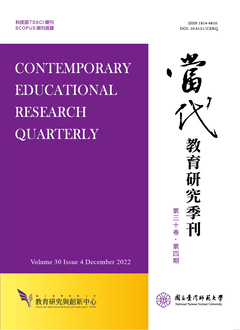

研究目的
過去文獻大多探討新住民子女在學習表現及生活適應普遍落後本地子女,卻缺乏探究對其劣勢可能的中介因素,故有必要加以確認進而弭平其差異。本研究以學齡前3歲幼兒樣本進行分析,以族群(新住民幼兒對本地幼兒)為自變項,探討兩者對認知、語言、社會、情緒能力之影響,並瞭解家庭環境中環境多樣、學習材料、學習刺激在兩者對各項能力之間所扮演的中介角色。
研究設計/方法/取徑
本研究使用資料取自「臺灣幼兒發展調查資料庫」第一波調查36個月齡組的學齡前幼兒樣本。從2,164案的資料庫中,刪除題項具有遺漏值樣本,篩選出父母皆為本國籍之本地幼兒1,889名,以及父母親其中一方為本國籍,另一方為新住民(含大陸與港澳地區及東南亞籍配偶)之新住民幼兒166名。研究工具包括基本資料問卷、幼兒認知發展家長問卷、二至六歲嬰幼兒語言發展家長問卷、社會情緒發展問卷、家庭環境之環境多樣、學習材料、學習刺激指標,透過PROCESS進行多重中介分析。
研究發現或結論
研究結果發現,控制父母社經地位、教育程度後,新住民幼兒各項能力與家庭環境各層面之得分均顯著低於本地幼兒;家庭環境各層面與各項能力呈現正相關;學習刺激、學習材料可以完全中介新住民幼兒與本地幼兒在認知能力上的差異;學習刺激、學習材料與環境多樣可部分中介新住民幼兒與本地幼兒在語言、社會、情緒能力上的差異。即新住民幼兒與本地幼兒在認知能力的差距,可能因新住民幼兒之學習刺激與學習材料較本地幼兒不足所致;而在語言、社會、情緒能力的差異,可部分歸因於學習刺激、學習材料與環境多樣的缺乏所致。
研究原創性/價值
此研究為國內首創探討家庭環境中環境多樣、學習材料、學習刺激對新住民幼兒與本地幼兒各項能力的中介效果。家庭環境屬於後天教養影響,可知不同族群幼兒的差異因環境因素所影響,若能補足學習環境的缺失,有機會使新住民幼兒的劣勢完全消弭。本研究具體分析新住民幼兒劣勢的可能影響因素,建立更完整的家庭環境與認知、語言、社會、情緒能力發展研究,由此突顯本研究之價值。
教育政策建議或實務意涵
建議新住民父母提供豐富的環境多樣、學習材料、學習刺激之學習資源為重要關鍵,家庭環境各層面對新住民幼兒各項能力的影響略有不同,尤其在學習刺激對認知、語言、情緒能力影響最大;學習材料對社會能力影響最強,若要提升不同能力應提供適切的學習資源,以增進新住民幼兒能力發展,縮短其與本地幼兒的差距。
Purpose
Previous research has mostly explored how new immigrant preschoolers lag behind their native peers in terms of academic performance and their adjustment to life without investigating the possible mediators of their disadvantages. It is thus necessary to identify such mediators and to try to eliminate such differences. In this study, 3-year-old preschoolers were analyzed. Ethic group (new immigrant versus native) was used as an independent variable to investigate its impact on cognitive, language, social and emotional competencies. In addition, the mediating roles of environmental diversity, learning materials and learning stimulation on the competencies of preschoolers were explored.
Design/methodology/approach
The data used in this study were collected from 36-month- old preschoolers during the first Kids in Taiwan: National Longitudinal Study of Child Development and Care (KIT) survey. After samples with missing data were removed from a dataset of 2,164 preschoolers, 1,889 native preschoolers (both parents have Taiwanese nationality) and 166 immigrant preschoolers (one parent has Taiwanese nationality and the other is an immigrant from mainland China, Hong Kong, Macao or Southeast Asia) were selected. As research tools, we used a basic informational questionnaire; a behavioral rating inventory of cognitive development for 2- to 5-year-old children administered as a parent assessment; an inventory of language development for 0- to 6-year- old children administered as a parental questionnaire; a social- emotional development questionnaire; and a family environment questionnaire measuring environmental diversity, learning materials and learning stimulation. A multiple mediator analysis was performed using PROCESS.
Findings/results
After the parents’ socioeconomic status and education levels were controlled for, the new immigrant preschoolers had significantly lower scores on all competencies and family environment dimensions than the native preschoolers, and all family environment dimensions were positively correlated with all competencies. In addition, learning stimulation and learning materials completely mediated the difference in cognitive competence between the new immigrant and native preschoolers, whereas learning stimulation, learning materials and environmental diversity partially mediated differences in language, social and emotional competency between the new immigrant and native preschoolers. That is, the gap in cognitive competence between new immigrants and native preschoolers may be because new immigrants receive less learning stimulation and learning materials than native preschoolers. The differences in language, social and emotional competency found between the new immigrant and native preschoolers can be partially attributed to a lack of learning stimulation, learning materials and environmental diversity.
Originality/value
This study is the first in Taiwan to investigate the mediating effects of multiple family environmental factors, including environmental diversity, learning materials and learning stimulation, on various competencies of new immigrant and native preschoolers. The family environment is an acquired factor that affects preschoolers differently. Improved learning environments might help eliminate the disadvantages facing immigrant preschoolers. This study specifically analyzes the possible influencing factors of the disadvantages of new immigrant preschoolers and establishes a more complete investigation of the effect of family environments on the development of these individuals’ cognitive, language, social and emotional competencies, demonstrating the value of this study.
Suggestions/implications
It is recommended that new immigrant parents provide high- quality learning resources with environmental diversity, learning materials and learning stimulation at their core. Family environments have different impacts on the various competencies of new immigrant preschoolers. In particular, learning stimulation has the greatest impacts on cognitive, language and emotional ability, while learning materials have the greatest impacts on social competence. Appropriate learning resources should be provided to effectively guide the development of various competencies in new immigrant children and to thus reduce the gap between them and native children.

本著作係採用創用 CC 姓名標示-非商業性 3.0 台灣 授權條款授權.
本刊國立台灣師範大學教育研究與創新中心
106台北市和平東路一段162號 | 電話: 02-7749-3670 | E-mail: cerecerq@gmail.com
教創中心 | 師大 | 電子報 | 線上投審系統
本刊由國家科學及技術委員會人文社會科學研究中心補助經費
© 2014 CERI-NTNU
